NCERT Solutions for Class 11 Biology Chapter 5 Morphology of Flowering Plants
These Solutions are part of NCERT Solutions for Class 11 Biology. Here we have given NCERT Solutions for Class 11 Biology Chapter 5 Morphology of Flowering Plants.
Question 1.
What is meant by modification of root? What type of modification of root is found in the:
(a) Banyan tree
(b) Turnip
(c) Mangrove trees.
Solution:
Root in some plants change their shape and structure and become modified to perform functions other than absorption and conduction of water and minerals. This change is called the modification of root.
(a) Banyan Tree has roots called prop roots which are hanging structures that help in support.
(b) Turnip has tap roots which get swollen and store food.
(c) Mangrove trees are found in a marshy area. The roots get modified into pneumatic structures providing extra passage to allow additional oxygen to the plant.
Question 2.
Justify the following statements on the basis of external features:
1. Underground parts of a plant are not always roots.
2. Flower is a modified shoot.
Solution:
1. It is true that roots develop below the ground but there are exceptions. Potato is one such example. Here, in this case, the stem gets modified into a ‘tuber’ like structure for the storage of reserve food material. These tubers develop and grow under the ground.
This can be proved by the following:
- The potato bears scale leaves (Leaves are found only in the stems)
- They contain buds in the regions called eyes.
- They contain nodes. It is justified from the above statements that underground parts of a plant are not always roots.
2. The flower is considered to be a modified shoot (it was suggested by Goethe 1760) because the internodes in a flower are highly condensed and the appendages such as sepals, petals, stamens, and carpels are generally large in number.
Question 3.
How is a pinnately compound leaf different from
a palmately compound leaf?
Solution:
In pinnately compound leaf, a number of leaflets are present on rachis (e.g., neem) whereas in palmately compound leaf, leaflets are attached at a common point i. e., at the tip of petiole e g., silk cotton.
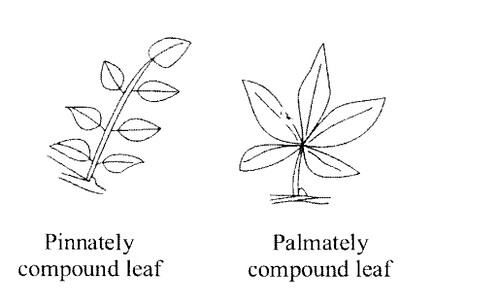
Question 4.
Explain with suitable examples the different types of phyllotaxy.
Solution:
- In a pinnately compound leaf, a number of leaflets are present on a common axis. Example: Neem leaves.
- In palmately compound leaf, a number of leaflets are attached at the common point.
Example: Cotton leaves.
Question 5.
Define the following terms:
- Aestivation
- Placentation
- Actinomorphic
- Zygomorphic
- Superior ovary
- Perigynous flower
- Epipetalous stamen.
Solution:
- Aestivation: The arrangement of sepals or petals with respect to one another in the floral bud is called ‘aestivation’.
- Placentation: It is the arrangement of placentae in the ovary. It may be marginally axile, parietal, basal, free central, and superficial.
- When a flower can be divided into t\Vo equal radial halves by any radial plane passing through the center, it is said to be actinomorphic as in mustard, Datura, chili.
- When a flower can be divided into two similar halves only in one particular vertical plane, it is zygomorphic, as in pea, Gulmohar, beam, Cassia, etc.
- Superior ovary: In the hypogynous flower the gynoecium occupies the highest position while the other parts are situated below it. The ovary in such flowers is said to be superior e.g., mustard, china-rose, and brinjal.
- Perigynous flower: If gynoecium is situated in the center and other parts of the flower are located on the rim of the thalamus almost at the same level, it is called a perigynous flower.
- Epipetalous stamen: When stamens are attached to the petals, they are epipetalous as in brinjal or epiphyllous when attached to the perianth as in the. flower of the lily.
Question 6.
Differentiate between
(a) Racemose and cymose inflorescence
(b) Fibrous root and adventitious root
(c) Apocarpous and syncarpous ovary
Solution:
The main difference between racemose and cymose inflorescence are as following:
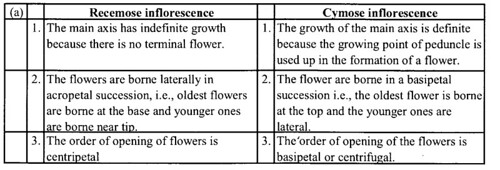
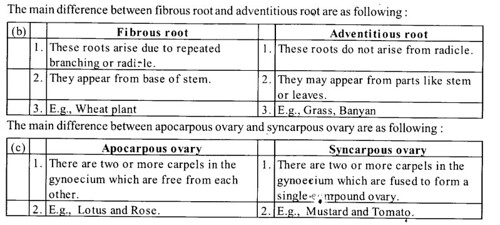
Question 7.
Draw the labelled diagram of the following:
(i) Gram seed
(ii) Y. S. of maize seed
Solution:
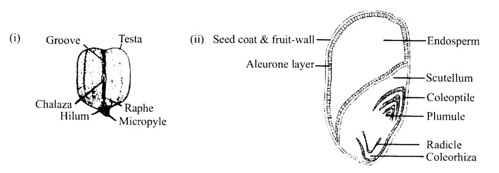
Question 8.
Describe modifications of the stem with suitable examples.
Solution:
The stem may not always be typically like what it is expected to be. They are modified to perform different functions, (fig. 5.2)
(1) For storage food: Underground stems of potato, ginger, turmeric, Samarkand, colocasia are modified to store food in them. They also act as organs of presentation to tide over conditions unfavorable for growth.
(2) Support: Stem tendrils, which develop from axillary buds, are slender and spirally coiled and help the plant to climb such as in gourds (cucumber, pumpkins, watermelon) and grapevines.
(3) Protection: Axillary buds of stems may also get modified into woody, straight and pointed thorns. Thoms is found in many plants which protect them from browsing animals such as Citrus, Bougainvillaea.
(4) For Photosynthesis: Some plants of arid regions modify their stems into flattened (Opuntia), or fleshy cylindrical (Euphorbia) structures. They contain chlorophyll and carry out photosynthesis.
(5) Spread Underground: Stems of some plants such as grass and strawberry, etc. spread to new niches, and when older parts die new plants are formed.
(6) Vegetative propagation: In plants like mint and jasmine a slender lateral branch arises from the base of the main axis and after growing aerially for some time arch downwards to touch the ground. A lateral branch with short internodes and each node bearing a rosette of leaves and a tuft of roots are found in aquatic plants like Pistia and Eichhomia. In banana, pineapple, and Chrysanthemum, the lateral branches originate from the basal and underground portion of the main stem, grow horizontally beneath the soil, and then come out obliquely upward giving rise to leafy shoots.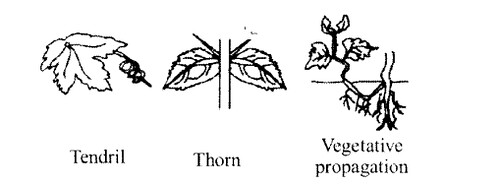
Question 9.
Take one flower each of the families Fabaceae and Solanaceae and write its semi-technical description. Also draw their floral diagram after studying them.
Solution:
Fabaceae: This family was earlier called Papilionoideae, a subfamily of family Leguminosae. It is distributed all over the world.
Example: Pisam sativum
Semi technical description of Pisum sativum ^ are as follows :
Vegetative characters :
Habit: An annual herb.
Root: Nodulated tap root.
Stem: Climber, leaflet tendrils
Leaves: Alternate, pinnately compound or
simple; leaf base, pulvinate, stipulate, venation reticulate.

Floral characters:
Inflorescence: Racemose
Flower: Bisexual, zygomorphic, complete,
irregular, hypogynous
Calyx: Sepal 5, gamosepalous, valvate aestivation.
Corolla: Petals 5, polypetalous, papilionaceous consisting of a posterior standard, two lateral wings, two anterior ones forming a keel. Thus, flower becomes zygomorphic, with descending imbricate aestivation i.e. vexillary aestivation.
Androecium: Stamen 10, diadelphous [1 + (9)], anther dithecous, introrse.
Gynoecium: Ovary superior, monocarpellary, unilocular with many ovules, marginal placentation.
Fruit: Legume
Seed: One to many, non-endospermic.

Economic importance
Many plants belonging to the family are sources of pulses (gram, arhar, sem, moong, soyabean, edible oil (soybean, groundnut); fibres (sun hemp); fodder (Sesbania, Trifolium), ornamentals (lupin, sweet pea); medicine (muliathi).
Solanaceae:
It is large family, commonly called as the potato family. It is widely distributed in tropics, subtropics and temperate ones. Example: Datura
Semi technical description of Solatium nigrum.
Vegetative characters:
Habit: Annual herb
Stem: Erect, cylindrical, hairy, slightly fistular. Leaves: Alternate, simple, petiolate, ovate with acute apex, venation reticulate.
Floral characters:
Inflorescence: Solitary, axillary
Flower: Ebracteate, actinomorphic, hypogynous
Calyx: Sepals 5, gamosepalous, persistent, valvate aestivation.
Corolla: Petals 5, gamopetalous, valvate aestivation
Androecium: Stamen 5, epipetalous Gynoecium : Bicarpellary, syncarpous, ovary superior, bilocular but four celled by formation of false septum, placenta swollen with many ovules.
Fruit: Spinous capsule with septifragal dehiscence.

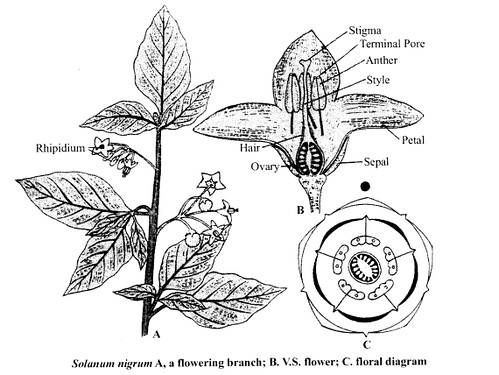
Question 10.
Describe the various types of placentations found in flowering plants.
Solution:
The arrangement of ovules within the ovary is known as placentation. The placentation of different types namely, marginal, axile, parietal, basal, central, and free central. In marginal placentation, the placenta forms a ridge along with the central structure of the ovary and the ovules are borne on this ridge forming two rows, as in pea. When the placenta is axial and the ovules are attached to it in a multilocular ovary, the placentation is said to be axile, as in china-rose, tomato, and lemon.
In parietal placentation, the ovules develop on the inner wall of the ovary or on the peripheral part. The ovary is one-chambered but it becomes two-chambered due to the formation of the false septum e.g. mustard and Argemone. When the ovules are borne on the central axis and septa are absent, as in Dianthus and Primrose; this type of placentation is called free central. In basal placentation, the placenta develops at the base of the ovary and a single ovule is attached to it, as in sunflower, marigold.
Question 11.
What is the flower? Describe the parts of a typical angiosperm flower.
Solution:
The placentation of flowering plants is the distribution of ovule-bearing cushions or placentae inside the ovary. It is of the following types.
- Marginal. A monocarpellary unilocular, ovary bears ovules longitudinally along the ventral suture in one or two alternate rows, e.g., Pea.
- Parietal. A syncarpous, unilocular ovary bears two or more placentae longitudinally along the wall, e.g., Fumaria, Viola. A false septum occurs between two parietal placentae in the Mustard. It makes the ovary falsely bilocular. In cucurbits, the three parietal placentae grow inwardly, meet in the centre and bend outwardly. The ovary becomes trilocular.
- Axile. A syncarpous bilocular to multilocular ovary bears ovules on the central axile column where the septa meet, e.g., China rose, Petunia, Asphodelus.
- Free central. Polycarpellary syncarpous but unilocular, ovary bears ovules around a central column which is not connected to the ovary wall.
- Basal. Unilocular ovary bears a single ovule from the basal region, e.g., Ranunculus, Sunflower.
- Apical. Unilocular ovary bears a single ovule from the apical region, e.g., Cannabis.
- Superficial. Ovules are borne along the inner surface of the ovary including the septa if present, e.g., Butomus (unilocular), Nymphaea (multilocular).
Question 12.
How do the various leaf modifications help plants?
Solution:
- Tendrils: Leaves are converted into tendrils for climbing as in pear or into spines for defense as in cacti.
- Bulb: The fleshy leaves of onion and garlic store food. In some plants such as Australian acacia, the leaves are small and short-lived.
- The petioles these plants expand, become green, and synthesize food. Leaves of certain insectivorous plants such as pitcher plants, Venus flytrap are also modified leaves.
Question 13.
Define the term inflorescence. Explain the basis for the different types of inflorescence in flowering plants.
Solution:
- The arrangement and distribution of flowers on the floral axis are termed inflorescence.
- Depending on whether the apex gets converted into a flower or continues to grow, two major types of inflorescences are defined – racemose and cymose.
- In the racemose type of inflorescence, the main axis continues to grow, the flowers are borne laterally in acropetal succession, i. e., older flowers are at the base and younger flowers are at the top.
- In cymose type of inflorescence, the main axis terminates in a flower, hence is limited in growth.
- The flowers are borne in a basipetal order, i.e., younger flowers are near the base and older
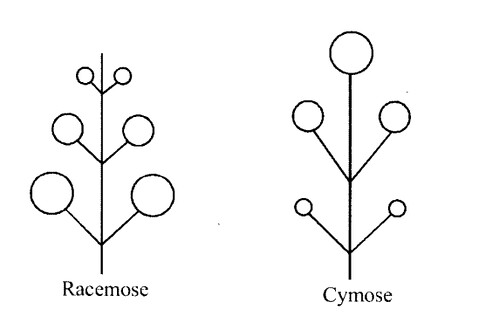
Question 14.
Writethefloral formula of an actinomorphic, biserial, hypogynous flower with five united sepals, five free petals, five free stamens and two united carples with superior ovary and axile placenta tion.
Solution:
![]()
Question 15.
Describe the arrangement of floral members in relation to their insertion on the thalamus. Calyx, corolla, androecium, and gynoecium.
Solution:
The flower is the reproductive unit in the angioSperms. It is meant for sexual reproduction.
A typical flower has four different kinds of whorls. arranged successively on the swollen end of the stalk or pedicel, called thalamus or receptacle. These are calyx, corolla, androecium, and gynoecium. Calyx and corolla are accessory organs, while androecium and gynoecium are reproductive organs. In some flowers like lily, the calyx and corolla are not distinct and are termed as perianth. When a flower has both androecium and gynoecium, it is bisexual. A flower having either only stamens or only carpels is unisexual.
In symmetry, the flower may be actinomorphic (radial) or zygomorphic (bilateral). When a flower can be divided into two equal radial halves in any radial plane passing through the center, it is said to be actinomorphic e.g. mustard, datura, chili. When it can be divided into two similar halves only in one particular vertical plane, it is zygomorphic e.g., pea, Gulmohar, bean, cassia. A flower is asymmetric (irregular) if it cannot be divided into two similar halves by any vertical plane passing through the center as in canna.
A flower may be trimerous, tetramerous, or pentamerous when the floral appendages are in multiples of 3,4 or 5, respectively. Flowers with bracts (reduced leaf found at the base of the medical) are called bracteate and those without bracts, ebracteate. Based on the position of calyx, corolla, and androecium in respect of the ovary and thalamus, the flowers are described as: hypogynous; perigynous, and epigynous. In the hypogynous flower, the gynoecium occupies the highest position while the other parts are situated below it. The ovary in such flowers is said to be superior e.g., mustard, china-rose, and brinjal.
If gynoecium is situated in the center and other parts of the flower are located on the rim of the thalamus almost at the same level, it is called perigynous. The ovary here is said to be half inferior e.g., plum, rose, peach. In epigynous flowers, the margin of the thalamus grows upward enclosing the ovary completely and getting fused with it, the other parts of the flower arise above the ovary. Hence, the ovary is said to be ‘inferior’ as in flowers of guava and cucumber, and the ray florets of sunflower.
VERY SHORT ANSWER QUESTIONS
Question 1.
What does take over the function of photosynthesis in Opuntia?
Solution:
Strm
Question 2.
Which plant part has transformed into the following different modifications
(i) tendril of pumpkin
(ii) thorn of Citrus.
Solution:
Stem(Axillary buds)
Question 3.
Name a cultivated plant in which neither fruits nor seeds are formed.
Solution:
Sugarcane
Question 4.
What term is given to the arrangement of leaves on the stem?
Solution:
Phyllotaxy
Question 5.
Give one example where the epigynous type of flower is present.
Solution:
Sunflower
Question 6.
Which type of placentation is present in Lathyrusl.
Solution:
Marginal
Question 7.
Why are potato and sweet potato called tubers?
Solution:
Potato and sweet potato are called tubers because they are irregularly shaped swollen stem that stores plenty of food.
Question 8.
What is phyllode? Give one example of it.
Solution:
Petiole and rachis modified into leaf-like structures are called phyllodes. e.g., Parkinsonia Australian Acacia.
Question 9.
Distinguish between alternate and whorled phyllotaxy.
Solution:
In alternate phyllotaxy, only one leaf is borne at each node whereas in whorled phyllotaxy, more than two leaves are borne at each node.
Question 10.
What is a tetradynamous condition of stamens?
Solution:
Two out of six stamens are short while the remaining four are long.
Question 11.
Describe the corolla of the family – Fabaceae
Solution:
Corolla of family Fabaceae is papilionaceous i. e., consisting of posterior standard or vexillum, two lateral wings and anterior petals fused along margin to form keel or carina.
Question 12.
What is a floral diagram?
Solution:
Floral diagram is an illustration of the relative and number of parts in each of the sets of organs comprising a flower.
Question 13.
Give any two reasons to justify that the onion bulb is a modified stem.
Solution:
It bears a large number of fibrous adventitious roots at its base. It bears several fleshy sheathing leaf bases and a terminal bud.
Question 14.
What are the main characters of the family Brassicaceae?
Solution:
Tetramerous flowers, six stamens, bicarpellary gynoecium, siliqua type fruit.
Question 15.
Name the food-yielding plants of Liliaceae.
Solution:
Allium cepa, A. sativum and Asparagus racemosus.
Question 16.
What is meant by maturation zone?
Solution:
The part of the root which is most active in water absorption is called the maturation zone.
Question 17.
What type of function is performed by the fleshy leaves of onion and garlic?
Solution:
The function of fleshy leaves of onion and garlic is storage
SHORT ANSWER QUESTIONS
Question 1.
What is a fruit? Describe the parts of a fruit.
Solution:
The fruit is a characteristic feature of flowering plants. It is a mature or ripened ovary, developed after fertilisation.
The fruit consists of a wall or pericarp and seeds. The pericarp may be dry or fleshy. When pericarp is thick and fleshy, it is differentiated into the outer epicarp, the middle mesocarp and the inner endocarp.
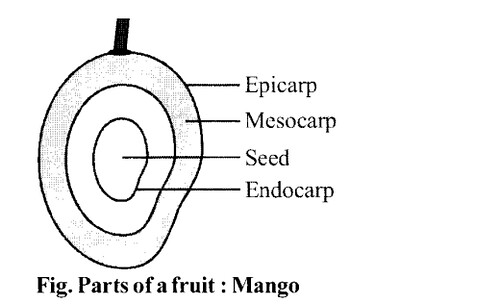
Question 2.
Distinguish between prop roots and stilt roots
Solution:
The main differences between prop roots and stilt roots are as following
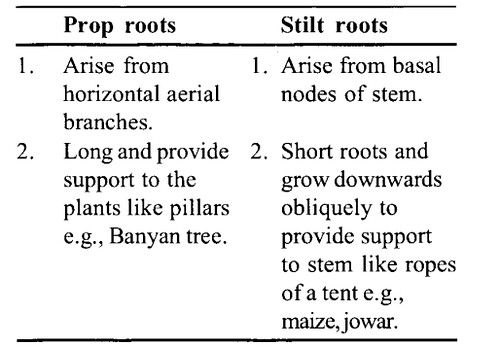
Question 3.
What is pneumatophore? How do they help the plant? Name an example.
Solution:
Pneumatophores:
- These are the roots that grow vertically upwards and come above the soil surface; they bear opening called pneumatophores, for the exchange of gases.
- This feature is an adaptation for plants growing in marshy/swampy areas, where oxygen is deficient in the soil.
- These roots help the plants to get oxygen from the air for respiration e.g., Rhizophora.
Question 4.
What is the function of the leaf?
Solution:
The leaf is a green, flattened outgrowth of the plant arising from the node of the stem and is specialized to perform the process of photosynthesis. Therefore, the leaf is also known as the kitchen or food factory of the plant.
Question 5.
What is the main function of the root system?
Solution:
The root, system generally grows beneath the ground into the soil, functions of the root system are as follows:
- It provides great anchorage and support to the plant. Huge trees such as mango, redwood stand erect due to the root.
- The root hair absorbs nutrients, water, and oxygen from the soil and conducts them to the upper parts of my plants.
- some of the taproots are specially modified for the storage of carbohydrates and water.
Question 6.
What is the aleurone layer?
Solution:
The major part of the grain is occupied by large endosperm which is rich in starch. The endosperm has one to three-layered peripheral protein layer called the aleurone layer which separates the embryo with endosperm.
LONG ANSWER QUESTIONS
Question 1.
Describe the various parts of an angiosperm plant with a well labelled diagram.
Solution:
Parts of an angiosperm plant: The body of an angiosperm plant consists of the following parts:
- root
- stem
- leaves
- flowers
- fruits
- seeds
(i) Root: It is mostly underground and colourless. It is profusely branched. Its main function is to give support to the plant, fix the plant in the soil, and absorb water and food from the soil.
(ii) Stem: It is the aerial part. It bears fruit, leaves, branches, flowers, etc., and conducts water and minerals from the roots to the various parts of the plant body. The leaves on the stem arise from nodes. The region of the stem between two nodes is called the internode. Leaf axil is the angle formed by the base of the leaf and stem. At each leaf, axil is present a bud, which gives rise to a branch.
(iii) Leaf: These are green in colour. Leaves are termed food factories. The large portion of the leaf is termed as lamina while the stalk is called as petiole.
(iv) Flowers: These are variously formed and attractively coloured structures of the plant. They produce fruits and seeds.
(v) Fruits: The fruit is a characteristic feature of flowering plants. Generally, the fruit consists of a wall or pericarp and seeds. The pericarp may be dry or fleshy. When pericarp is thick and fleshy, it is differentiated into the outer epicarp, the middle mesocarp and the inner endocarp.
(vi) Seeds: The ovules after fertilisation, develop into seeds. A seed is made up of a seed coat and an embryo.
The embryo is made up of a radicle, an embryonal axis, and one (as in wheat, maize) or two cotyledons (as in gram and pea)
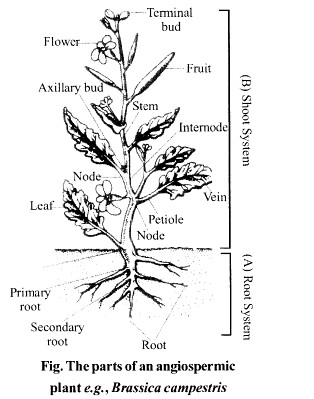
Question 2.
Mention the diagnostic characters of the family Fabaceae and write the floral formula
Solution:
Diagnostic characters of family Fabaceae are:
- Presence of nodulated roots.
- Inflorescence racemose.
- Perigynous ovary.
- Flower zygomorphic and papilionaceous.
- Calyx 5, gamosepalous.
- Corolla 5, petals unequal and differentiated into standard, 2 lateral wings and two smallest anterior petals (keel).
- Androecium commonly diadelphous (1+9 or 5 + 5) or monoadelphous (10 or 9)
- Gynoecium monocarpellary, ovary is unilocular with marginal placentation.
- Fruit legume.

Question 3.
Write five differences between a dicot seed and a monocot seed.
Solution:
The differences between dicot seeds and monocot seeds are:
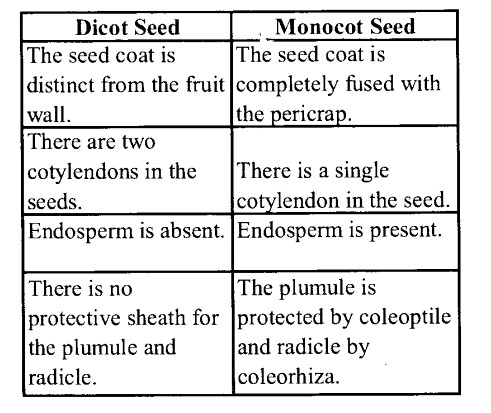
Question 4.
Describe placentation in flower:
Solution:
The arrangement of the placenta in the ovary of the flower is known as placentation. Its main function is to transfer nutrients from maternal tissue to the growing embryo.
- Marginal placentation: It is found in the monocarpellary ovary. In this, the ovary is unilocular and ovules are arranged along the margin of the unilocular ovary. Ex- Pea, Clitoria, etc.
- Axile placentation: It is found in bi or multicarpellary and multilocular ovary. Ovules are arranged along the central axis of placenta and the number of chambers corresponds to the number of carpels. Ex- Lemon, Tomato, Hibiscus, Cotton, etc.
- Parietal placentation: It is found in bi or multicarpellary ovary but unilocular. Ovules are arranged along periphery or the inner walls of ovary and the number of placenta corresponds to the carpels. Ex – Cucurbita, Argemone, etc.
- Free central placentation: It is found in multicarpellary syncarpous ovary. Ovules are borne along the central axis. Which is not connected with the ovary wall by the septum.
Ex- Dianthus Rome primrose, etc. - Basal placentation: It is found in monocarpellary but unilocular. In this placentation, the placenta develops at the base of the ovary and a-single ovule is attached to it. Ex – Sunflower, etc.
We hope the NCERT Solutions for Class 11 Biology at Work Chapter 5 Morphology of Flowering Plants, help you. If you have any query regarding NCERT Solutions for Class 11 Biology at Work Chapter 5 Morphology of Flowering Plants, drop a comment below and we will get back to you at the earliest.